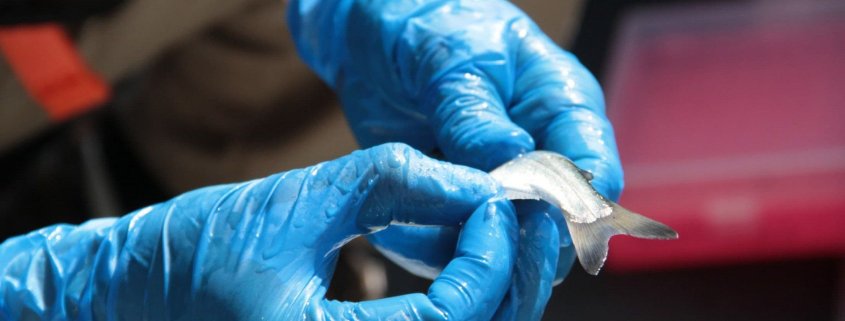
Fit-Chips
A workhorse of our program is the salmon “Fit-Chip,” which allows us to determine which genes an individual salmon has turned on in response to encountered challenges.
| Naturally, the SSHI touched on the contentious topic of salmon farming, and the disease risk it might pose to wild fish. There was general suspicion that open-net salmon aquaculture operations were contributing to salmon declines, but the issue lacked scientific clarity. Research from the SSHI confirmed that open-net salmon farms do indeed pose a risk due to the transfer of parasites and disease-causing pathogens between wild and farmed salmon. The findings prompted PSF to take a clear position that salmon farming needs to transition away from operating in open-net pens where wild salmon and hatchery stocks could be affected. |
Importantly, Fit-Chip technology, developed in the DFO Molecular Genetics Laboratory as part of the SSHI, uses non-lethal gill biopsy samples, and can therefore be applied even on salmon stocks of high conservation concern. This technology promises invaluable insights for salmon. Once we know where salmon are most challenged, and the kinds of environmental stressors that are most closely linked with survival, we can move to mitigate stressors under our control.
It’s a little like glancing at the dashboard of your car: is your check-engine light on? Is your fuel low? If we monitor enough cars, and they all tend to run out of fuel at a certain place on the highway, it just might be worth building a gas station a little way up the road. In the case of BC salmon, detecting clusters of infectious-agents has provided evidence supporting the removal of open-net salmon farms from wild-salmon migration routes. Moving forward, if we find (for example) that juvenile salmon emerging from freshwater have trouble dealing with a high-salt environment, we might suggest rehabilitation of brackish estuary habitats, so those salmon can incrementally adjust to salt water before heading out to sea.
What is the History?
In 2011 the Pacific Salmon Foundation, in partnership with the Department of Fisheries and Oceans (DFO) and Genome BC, embarked on the Strategic Salmon Health Initiative (SSHI) to better understand how infectious agents affect the health of wild salmon. Under the direction of Dr Brian Riddell (PSF) and Dr Kristi Miller (DFO), the SSHI developed cutting-edge genetic and genomic tools to screen salmon for infectious agents, uncover linkages to disease, identify previously unknown salmon viruses, and determine the environmental “stressors” that individual salmon face.
Over the course of the program, we gained unprecedented insight into the impacts of infectious agents on wild Pacific salmon. Diseased fish are very difficult to find in the wild, because the challenges of day-to-day life – finding food, avoiding predators, completing epic migrations – tend to result in mortality of these fish. To overcome this difficulty, we surveyed salmon up and down the BC coast: in rivers, in the ocean, in hatcheries, and on salmon farms, with our total sample size of 34 000. From there, we applied our new genetic tools to screen for infectious agents and start teasing apart the complex and interconnected story of “salmon health” in BC. We reasoned that if infectious disease is inherently hard to find in salmon, we could at least screen for infectious agents known to cause diseases in salmon around the world.
As an overarching goal, the SSHI sought to develop cutting-edge technologies and use them to paint a holistic picture of salmon health in BC, from spawning beds and hatcheries, downstream to the coastal marine environment, past salmon farms and natural challenges, out to sea, and back. Working hand in hand with DFO’s Molecular Genetics Lab, our innovative approaches included application of the high-throughput Fluidigm Biomark genetic quantification platform to screen for infective agents, development of novel “genetic stains” to allow identification of infected tissues under the microscope, characterisation of gene-expression signals that indicate viral disease and other stressor states in individual fish, and discovery of novel viruses through sequencing the unidentified genetic material in sick fish. Some of these technologies developed under the SSHI banner were adapted from the human genome project; others were being developed in parallel within the human-health field. Our innovations have been recognised in Canada and internationally, as multiple groups, including internationally respected researchers and BC First Nations, continue to seek SSHI expertise to help apply our tools in conserving their own local salmon.
By the end of 2020, we had generated over 3.2 million data points, uncovered relationships between infectious agents and salmon survival, shown that some infections coming from open-net salmon farms were placing wild salmon populations at risk, and revealed seventeen unknown viruses in BC – of which fifteen species are brand new to science. This work has resulted in 56 peer-reviewed scientific publications to date, with more on the way.
